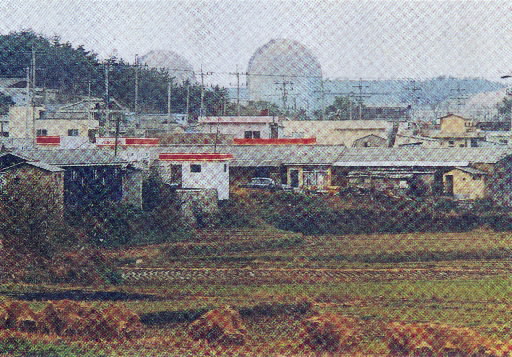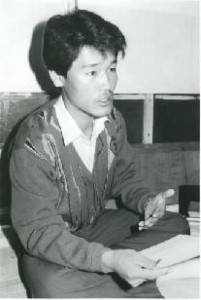1. Deformities Spawn Fear and Distrust
Feb. 27, 2013
Chapter 4: India, Malaysia, Korea
Part 3: South Korea’s Poisonous Emissions
Part 3: South Korea’s Poisonous Emissions
The people of South Korea often speak of the miracle of the Hangang. The miracle refers to the incredible economic growth over the past few decades which has affected the heart of the nation, symbolized by the River Hangang, Seoul's main artery. In recent years the continued development of the economy has been accompanied by the increased use of nuclear power. In 1988, 46.9 percent of South Korea's electricity was supplied by this means, making it the world's third-largest user of atomic energy for power generation. Since the advent of democracy in 1988 a fierce debate has been raging concerning the effect of the nuclear power plants on the health of the people employed by them and those living close by.
1. Deformities Spawn Fear and Distrust
Enormous trucks thundered past one after the other as we drove through forests of dark pines approximately thirty-five miles from Kwangju, the capital of Chollanam-do province. Leaving the valley, we headed for the sea, where beyond a group of farms we could see the giant domes of a nuclear power plant towering over the surrounding countryside.
With a capacity of 950,000 kilowatts, reactors No. 1 and 2 at Yeonggwang are the largest type in use in South Korea. Just beyond the wire fence of the complex is the village of Seongsan, which has a population of three thousand. It was an incident which took place in this quiet rural backwater that started the nuclear debate in South Korea in the summer of 1989.
"Wife of Yeonggwang Power Plant Employee Miscarries Two Children Without Brains." The employee, Kim Ik-Sung, has had little peace since this headline appeared in a local paper on July 29 of that year. It sparked a wave of "radiophobia" never before seen in the history of nuclear power development in South Korea.
"I swear it's true. I really did have to work in there without any protective clothing." Hugging his knees, Kim seemed lost in thought. The psychological burden of having thrown down the gauntlet to the government and the Korea Electric Power Corporation was obviously weighing on him heavily, along with the endless visits from reporters, lengthy investigations, and being branded as "the father of deformed children."
Kim is the fifth son of a farming family, and after leaving junior high school he helped out on the family farm. While there he also did some temporary work for a subcontractor at the Yeonggwang plant straight after the birth of his eldest daughter in March 1987. He worked for three hours in one of the boron mixing tank rooms, breaking up brown clods of the mixture with a hammer. The room was within the radioactive danger zone of the No. 2 reactor.
"They stopped me when I first entered the room because I wasn't wearing protective clothing, but one of the bosses who was with me made me go in anyway. They didn't take a note of my name." At the time Kim did not know what was meant by the sign "Radioactive Zone."
For the next twenty-six days he worked outside the zone, during which time he was constantly plagued by headaches and dizziness. Kim's wife had her first miscarriage in November 1988 at the age of twenty-eight. The child, which weighed just under four pounds, had a head half the normal size. The incident became a taboo topic even within the family. The second miscarriage took place in June 1989, by which time Kim was working as a security guard at the corporation's housing estate. Once again the fetus was found to be without a brain, and it was aborted by caesarian section. According to the doctors at Yeonggwang General Hospital, these unusual miscarriages could have been caused by hereditary factors, by drug or chemical poisoning—or by exposure to radiation.
News of the second miscarriage began to spread by word of mouth until finally it became the focus of a series of articles in the Korean press. On August 1, a group of doctors from Kwangju announced that, according to the results of a health survey carried out in Seongsan, "Abnormally high levels of white blood cell reduction and anemia have been observed not just in the father of the microcephalic child but also in other residents living near the nuclear power facility." Overnight the concern about exposure to radiation reached new heights.
The Ministry of Science sent out its own survey team the day after this announcement was made. Their interviews with local residents revealed that another employee at the plant had given birth to a deformed child, and the rumors about radioactive contamination spread even further.
In the midst of the debate Kim left his security guard job and quietly took his wife and daughter to the outskirts of the village to live. "If only I hadn't done that work at the plant... ," he said, falling silent once again.
We were shown into the boron mixing room at the Yeonggwang plant where Kim had worked without protective clothing. Once inside the plant, we had stripped down to our underwear and changed into yellow overalls as protection from radiation. On our chests we placed two types of radiation detectors. When the heavy doors opened we were hit by an oppressively warm blast of air. The needle on our geiger counter started to move and stopped at 0.05 millirems.
"The people around here are kicking up such a fuss about the plant being dangerous, they just don't know anything about radiation, that's all," commented our guide, the section chief. We just watched the needle on our counter and thought about another incident we had heard about involving Kim Dong-Pil, aged twenty-two, a distant relative of Kim Ik-Sung. Kim Dong-Pil lives with his parents, two brothers and a sister, and his wife and two-year-old daughter next to the gate of the power plant. His daughter was born with deformed ankles. We visited him at home.
"I'd really like to get a job, but I just feel tired all the time," he told us forlornly.
On August 3, 1989, Dong-Pil was thrust into the limelight after he participated in a meeting between the villagers and the medical survey team which had rushed to the area after hearing Kim Ik-Sung's revelations. Dong-Pil asked one of the doctors if his daughter's disability had anything to do with his work at the power plant. That same night the television news reported that the "daughter of an employee at a nuclear power plant had been born with a genetic defect," and Dong-Pil's case became known across the nation.
Dong-Pil went to work at reactor No.1 in July 1986, just before it began commercial operations. Like Kim Ik-Sung, he was working for a subcontractor, lured by the 90,000 won (approx. U.S.$140) per day, ten times the usual wage. He met the other seven workers in the area for the first time the day he started. They received no safety instruction. The men worked in the radioactive area for two fifteen-minute stretches a day for two days, a total of one hour, the work consisting of changing pipes in the pressurizer. For the first fifteen-minute stretch they carried a pocket radiation detector which measured up to 200 millirems; for the second a device which measured up to 500. Unable to bear the stifling heat Dong-Pil took off his mask while he cleaned the welded joints in the pipes. On several occasions, after he had finished, the light on the contamination monitor would flash a warning red. Dong-Pil, however, was never told that he was responsible for taking a note of the radiation levels.
Several days after the management had heard rumors about high levels of radiation, Dong-Pil was summoned to the environmental radiation laboratory for testing. He was never given detailed results, but the figure of "seven or eight hundred millirems" uttered by the technician remained in his head. Not long after this, his hands were covered in odd swellings. A year later his disabled daughter was born.
The Korea Electric Power Corporation insists that Dong-Pil's level of radiation was 70 millirems. This is less than the level of 5,000 millirems which the International Council for Radiation Protection (ICRP) has designated a safe limit for workers at nuclear facilities, and is not large enough a quantity to cause headaches or skin diseases, according to the plant management. The corporation denies that Dong-Pil even entered the radioactive zone. In reply to the claims of these one-time employees of the company, the Ministry of Science has announced it will allow them to be examined overseas, in accordance with their wishes. As Dong-Pil told us, "As a Korean, it makes me deeply ashamed that I can't trust the medical establishment in my own country. But the corporation and the government just keep denying everything."
Dong-Pil, who once held a second dan in Taekwondo, now spends his days pottering round at his parents' restaurant trying to help out. Fellow villagers who had promised to support him have now turned against him since Dong-Pil expressed his wish to be examined overseas, and he has become the target of abuse. "I feel as if I'm up against a brick wall all the time," he confided. He grows more anxious with each passing day. "All I want is a proper examination and to know exactly what the effects of the radiation are. Until then, I'm too afraid to have any more children."









